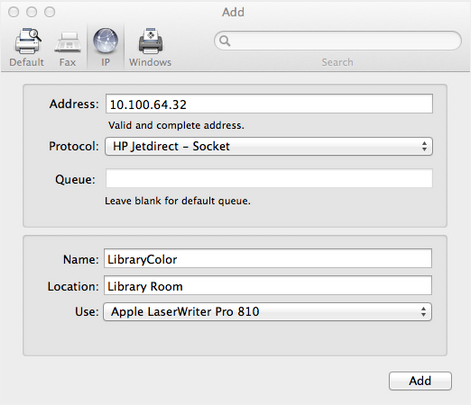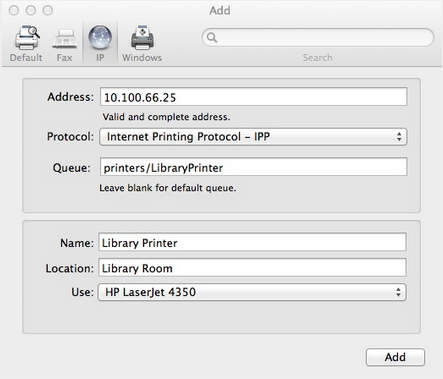Mac hosted print queues for OS 10.8+
This section discusses printer setup on systems where print queues are hosted on Mac OS 10.8+. There are some very minor differences between the two setup instructions, but they follow the same structure. See Windows hosted print queues if you have Windows hosted print queues.
Installing the printers
Install the printer on the system running PaperCut using a compatible driver. For example, a driver supplied by Apple or the manufacturer. If there is a choice of driver, we recommend a Postscript or PPD based driver. Follow the manufacturer's suggested setup procedure for this part of the implementation. If the manufacturer supports various connection methods, we recommend using JetDirect/Socket if possible. Here is an example of a procedure that sets up a standard printer using a plain JetDirect/Socket connection:
-
Select System Preferences.
-
Select Print & Scan (in 10.9, this is named Printers and Scanners) .
-
Click + to add a new printer.
-
Click the IP tab.
-
In the Protocol list, select HP Jetdirect - Socket.
-
Enter the printer's IP address.
-
Give the printer a simple name without spaces.
-
Select the driver or printer model from the list; then click Add.
Print some test pages to the newly configured printer, such as printing a web page from Safari. Confirm that printing works as expected before continuing. Be sure to test multiple options such as Duplex and Grayscale. If printing is not working as expected, see the troubleshooting section below.
If you are adding new printers, configure PaperCut to monitor the new print queues. For more information, see Add and remove/delete/ignore printers.

Tips and troubleshooting
-
Always try HP Jetdirect/Socket first, and use proprietary connection methods as a last resort
-
If your printer does not support HP JetDirect/SocketHP JetDirect Socket describes the process in which the printer is connected to the server/system. A JetDirect Socket means that the server communicates with the printer via a standard TCP socket connection over the network. This method of connection is often called a Standard TCP/IP Port in other non-HP brands, and the process is commonly refereed to as setting up a “networked printer”. The TCP port used for communication is port 9100., consider using IPPThe Internet Printing Protocol (IPP) is an Internet protocol for communication between a print server and its clients. It allows clients to send one or more print jobs to the server and perform administration such as querying the status of a printer, obtaining the status of print jobs, or cancelling individual print jobs. IPP can run locally or over the Internet. Unlike other printing protocols, IPP also supports access control, authentication, and encryption, making it a much more capable and secure printing mechanism than older ones. as an alternative
-
If you are not able to install or find a driver for your printer, try the Generic Postscript Driver/Printer
Sharing the printers
On Mac OS 10.8, Apple removed the ability to share printers using the Server Admin app. Sharing printers is now easier, however, LPDThe Line Printer Daemon protocol (LPD) is a network protocol for submitting print jobs to a remote printer. A server for the LPD/LPR protocol listens for requests on TCP port 515. A request begins with a byte containing the request code, followed by the arguments to the request, and is terminated by an ASCII LF character. An LPD printer is identified by the IP address of the server machine and the queue name on that machine. Many different queue names may exist in one LPD server, with each queue having unique settings. The LPD software is stored on the printer or print server. has since been removed as an sharing option, and the default sharing method is now IPP. To share your printers, follow the below steps:
-
Open System Preferences > Print & Scan on the print serverA print server is a system responsible for hosting print queues and sharing printer resources to desktops. Users submit print jobs to a print server rather then directly to the printer itself. A print server can be a dedicated server but on many networks this server also performs other tasks, such as file serving (in 10.9, this is named Printers and Scanners)
-
Click the printer you want to share
-
Select Share this printer on the network.
Setting up the printers on Mac workstations
Once the printers are set up on the server and shared, the next step is to install the printers on the workstations. This section includes the manual setup of print queues to workstations, as well as discussing a method of automating deployment via the Workgroup Manager. The goal is to add the printer on the workstation so it communicates with the server’s print queues rather than directly to the printer. Protocols include IPP, LPD, or LPD added via BonjourBonjour is Apple's implementation of zero-configuration networking (zeroconf), a group of technologies that includes service discovery, address assignment, and hostname resolution. Bonjour locates devices such as printers, other computers, and the services that those devices offer on a local network using multicast Domain Name System (mDNS) service records.. The recommended setup is to use IPP, as this is the native protocol.
Manual setup
-
Open System Preferences > Print & Scan on the workstation (in 10.9, this is named Printers & Scanners)
-
Click +.
-
Select IP as the type; then select Internet Printing Protocol - IPP as the Protocol. (If IPP is not compatible with this device, select Line Printer Daemon - LPD as the Protocol)
-
In the Address, enter your server name (or IP Address).
-
In Queue, enter the the printer's Queue Name prefixed with printers/. For example: printers/my_office_printer.
-
Select the appropriate driver under Print Using.
-
Select Printer Software. If your model is not listed here, install the manufacturer's driver and repeat these steps again
-
Take some time to test printing from the workstation, and confirm that all functions of the printer are working.
If you have trouble connecting, ensure the queue name you are entering is correct. The queue name of the printer is set when the print queueA print queue displays information about documents that are waiting to be printed, such as the printing status, document owner, and number of pages to print. You can use the print queue to view, pause, resume, restart, and cancel print jobs. is first created on the Mac server, and might be different to the visible printer name. The queue name is displayed on the print server under System Preferences > Print & Scan > [select printer] > Options & Supplies > General > Device Name.
If you have problems obtaining a driver for your printer, try the Generic Postscript Driver. This option works with most printers. If after a test print the printer stops with a connection error, check the printer sharing permissions on the server or try the alternate method discussed below.

Publishing the printer via Workgroup Manager
Manually installing the printer on each desktop on a large network can be tedious. Large networks using Open Directory can automate the process with Workgroup Manager. The key to successfully deploying/publishing printers via the Workgroup Manager is to publish the configuration from a working workstation rather than the server itself. The reason behind this is that it would publish the server's printer configuration. Since the server is configured to print direct to the device and not to the queue, this would be the incorrect configuration for user workstations. Instead, install the Workgroup Manager software on a configured workstation/client and publish its known configuration. We recommend having a workstation setup that is for Workgroup Manager administration and deployment only.
-
Select one workstation on your network. Follow the manual set up procedure as discussed above.
-
Test and confirm this workstation is configured and printing correctly. Also select other settings as appropriate such as tray, duplex and other defaults. It is important to test this step before continuing. If printing is not working, this needs to be fixed before Workgroup Manager is used to publish your print queues.
-
Install the Workgroup Manager on this client workstation found on the Mac OS X Server install disk).
-
Open the Workgroup Manager, connect to your directory, then select an appropriate user group or computer group used to manage client settings.
-
Enter the Settings/Preferences area; then select Printing.
-
Select Manage Always; then add printer(s) set up in step 1.
-
Save the settings and exit (e.g. click Done).
-
Log onto another workstation and confirm that printer settings are being published as expected.


